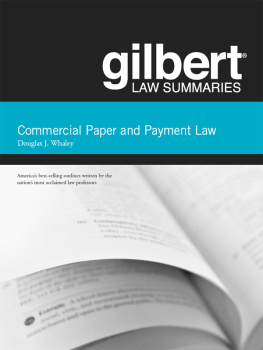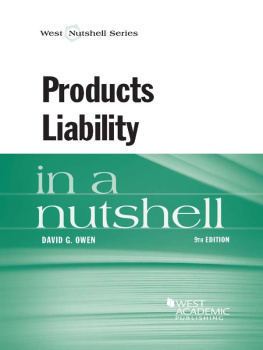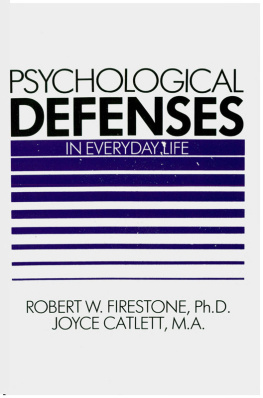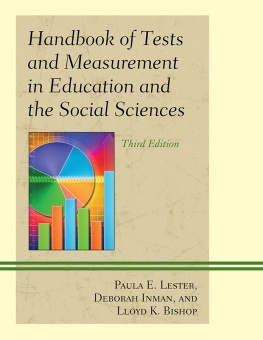I

Commercial Paper & Payment Law
by
DOUGLAS J. WHALEY
Ohio State University
Seventeenth Edition

Mat # 41307134
II
West Academic created this publication to provide you with accurate and authoritative information concerning the subject matter covered; however, the content was not necessarily prepared by persons licensed to practice law in a particular jurisdiction. The publisher is not engaged in rendering legal or other professional advice and this publication is not a substitute for the advice of an attorney. If you require legal or other expert advice, you should seek the services of a competent attorney or other professional.
Gilbert Law Summaries is a trademark registered in the U.S. Patent and Trademark Office.
2006 by Barbri, a Thomson business
2013 LEG, Inc. d/b/a West Academic Publishing
610 Opperman Drive
St. Paul, MN 55123
1-800-313-9378
West, West Academic Publishing, and West Academic are trademarks of West Publishing Corporation, used under license.
Printed in the United States of America
ISBN: 978-0-314-28269-9
III
Summary of Contents
Chapter Eight: Forgery or Alteration of Negotiable Instruments
IV
XIX
Approach to Exams
This Summary deals with the rights and liabilities of parties to commercial paper. Commerical paper is the term applied to the negotiable instruments most widely employed in everyday business practice-checks, drafts, promissory notes, and certificates of deposit.
Problems involving the rights and liabilities of parties to negotiable instruments usually can be analyzed by the following approach:
1. Negotiability
First of all, does the instrument meet formal requirements of negotiable paper? Unless it does, a holder has no greater rights than the assignee of an ordinary contract. Furthermore, if the instrument is not negotiable, Article 3 of the Uniform Commericial code may not apply.
2. Negotiation
If the instrument is negotiable, has there been such a transfer as to constitute a valid negotiation thereof-to vest in the transferee both possession and title to the instrument?
a. If there has not been a valid negotiation, what rights (if any) does the transferee of the instrument have?
3. Holder in Due Course
Has the instrument been negotiated to a holder in due course (HDC)? If so, does the other party to the dispute have a real or a personal defense?
4. Liability of the Parties
Consider the liability of each party to the instrument upon its issuance and following each transfer or negotiation thereof:
a. The obligation on the instrument itself:
(1) Primary party ( maker ).
(2) Secondary parties ( drawer, indorser ).
(a) Have the necessary steps been taken to fix their liability? What is the effect of failure or delay?
b. Implied warranty liability of every transferor.
c. Conversion liability in tort for failing to return the instrument, paying on a forged or missing instrument, or paying in violation of a restrictive indorsement.
d. Can liability be passed on to some other party? Under what theory?
XX
5. Defenses
Depending on which parties are sought to be held liable, what defenses exist and what defenses can be asserted?
a. Has the instrument come into the hands of an HDC ? If so, what is the effect?
b. Has any party otherwise entitled to assert defense acted in such a way so as to be estopped to assert the defense?
Chapter One:
Introduction to Commercial Paper
CONTENT
This chapter discusses the purposes of commercial paper and the historical background of the law in this area. While you are not likely to be tested on this introductory material, the law of commercial paper is best understood in light of these purposes and the important historical developments that culminated in Articles 3 and 4 of the Uniform Commercial Code.
This chapter also introduces you to the first issue to consider in any commercial paper problemwhether the instrument involved qualifies for coverage under Article 3. Is it a negotiable instrument or merely a contract in the process of being assigned? If it is not negotiable, it will not fall under the holder in due course (HDC) rule. This extraordinary rule provides that a negotiable instrument that reaches the hands of an HDC ( i.e. , a bona fide purchaser who is unconnected with the underlying transaction and who knows of no problems with the instrument) arrives free of most defenses. Thus, the HDC gets paid even though in a lawsuit between the original parties, payment would never be ordered because defenses exist. The policy here is to promote the free alienability of commercial paper by inspiring confidence in the purchaser that payment will be forthcoming in all but the rarest of circumstances. It has the unfortunate side effect of denying injured parties the ability to asset their legitimate defenses, and the tension between these conflicting polices has caused the courts much angst through the last two centuries.
1. The Credit Function
Some forms of commercial paper are used primarily to obtain credit now, to be repaid out of future income. Examples of such paper include promissory notes, certificates of deposit, and investment securities ( i.e. , stocks and bonds, which are covered by Article 8 of the Uniform Commercial Code (U.C.C.) and are therefore excluded from Article 3 [ see U.C.C. 3102(a)]).
a. Note
Creditors willing to extend credit in return for this type of instrument frequently demand security for the debt, in the form of collateral in which the creditor has a security interest ( see Secured Transactions Summary) or a surety ( see discussion of suretyship p. ).
2. The Payment Function
On the other hand, some types of commercial paper are used primarily as a means of paying obligations in lieu of money, which may be too awkward (or dangerous) to transfer directly. Checks, drafts, bills of exchange, and trade acceptances are examples of commercial paper used as payment.
1. The Law Merchant
The term law merchant (still in use today) refers to the law as it is understood by merchants and traders, and is an important source of authority in construing the various business devices used in commerce. The Uniform Commercial Code adopts it specifically in section 1-103(b) and through the adoption of usage of trade [section 1-303(c)] as a method of contract interpretation.
2. Uniform Commercial Code
In 1942, the National Conference of Commissioners on Uniform State Laws and the American Law Institute began drafting the Uniform Commercial Code. The U.C.C. was designed to replace many of the existing uniform acts governing commercial transactions.
a. Basic law on commercial paper
After going through many drafts to reach its present form, the U.C.C. has been adopted by every state except Louisiana (which did not adopt Article 2 of the Code on the law of Sales, but did adopt the other Articles, including the ones considered in this Summary). The chief provisions in the U.C.C. covered in a course on Commercial Paper (sometimes called Payment Law) are Article 3 on Commercial Paper (an updated version of the N.I.L.) and U.C.C. Article 4 on Bank Deposits and Collections (an updated version of the Bank Collection Code).
b. The 1990 Revision of Articles 3 and 4
Articles 3 and 4 of the Uniform Commercial Code were rewritten from the 1960 original and the revised version was sent to the states for adoption in1990. These changes (hereafter the Revision) clear up many of the problems with the original versions and permit banks to move from a paper-based system to electronic banking. The Revision was adopted in all jurisdictions except New York. This Summary will be devoted to the rules of the Revision, which the exception noted next.









